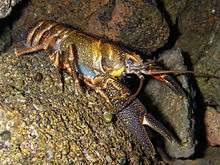Pacifastacus fortis
| Pacifastacus fortis | |
|---|---|
 | |
| Scientific classification | |
| Kingdom: | Animalia |
| Phylum: | Arthropoda |
| Subphylum: | Crustacea |
| Class: | Malacostraca |
| Order: | Decapoda |
| Family: | Astacidae |
| Genus: | Pacifastacus |
| Species: | P. fortis |
| Binomial name | |
| Pacifastacus fortis (Faxon, 1914) | |
Pacifastacus fortis (known as the Shasta crayfish or placid crayfish) is an endangered crayfish species endemic to Shasta County, California, where it is found only in isolated spots on the Pit River and Fall River Mills.
Description and ecology
P. fortis is thick and stocky, with relatively heavy chelae. It is usually dark brown dorsally with bright orange areas on its underside. It grows about 2-4 inches long. It lives in cold, clear, rocky areas of the mountain rivers, and feeds on the slime coating the rocks. The animal requires a constant, steady, and untainted flow of fresh water to survive.
Conservation
Pacifastacus fortis is listed as a critically endangered species on the IUCN Red List,[1] and an endangered species under the Endangered Species Act.[2] It has always had a very small native range, and that range has been significantly fragmented by such human activities as damming, mining, and agriculture. The signal crayfish, a recently introduced species, has outcompeted P. fortis in much of its range. The Pit River Fish Hatchery was closed to protect this species.
References
- ↑ D. Johnson; C. A. Taylor; G. A. Schuster; J. Cordeiro; T. Jones (2010). "Pacifastacus fortis". IUCN Red List of Threatened Species. Version 3.1 (3.1). International Union for Conservation of Nature. Retrieved October 6, 2010.
- ↑ "Shasta crayfish (Pacifastacus fortis) species profile". Environmental Conservation Online System. United States Fish and Wildlife Service. October 6, 2010.
External links
- B. Moose Peterson (December 17, 2009). "Species Account: Shasta Crayfish, Pacifastacus fortis" (RTF). United States Fish & Wildlife Service.
- "Recovery Plan for the Shasta Crayfish (Pacifastacus fortis)" (PDF). United States Fish & Wildlife Service. 1998.
